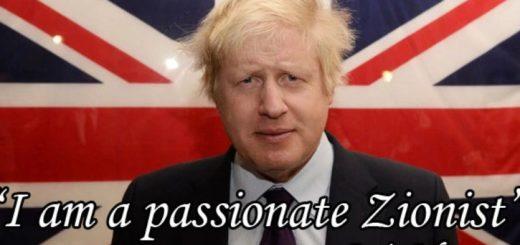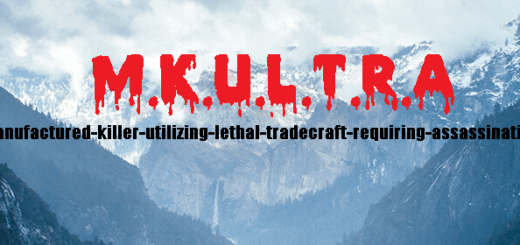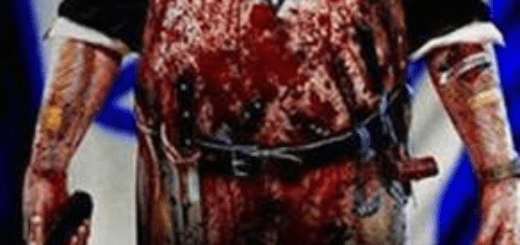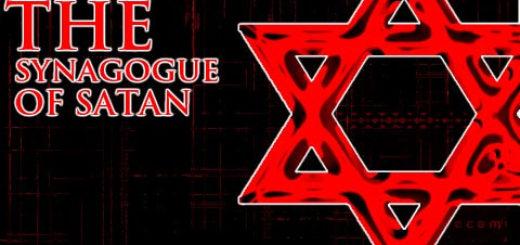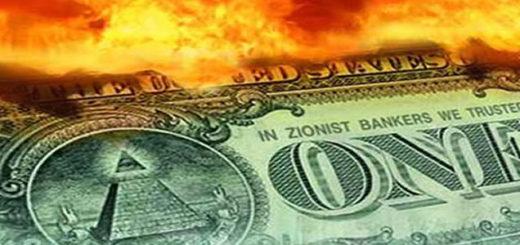These Facts Enunciated Below Are Why I Don’t Believe the Mainstream (Jewish) Media’s Version of Events to Hate Russia; Same Support WAR CRIMINALS OF UKRAINE!
“Not everyone, however, was satisfied with this haste to pronounce a verdict. The information released by the Ukrainian media and a number of media outlets in Europe and the United States, including The Sunday Times and The New York Times, raised more questions than it answered. Russian forces, as per a recent agreement with the Kyiv government, had withdrawn from Bucha, Irpin, and Hostomel in the afternoon of Wednesday 30 March, allowing forward units of the Ukrainian armed forces to begin retaking these towns that evening and through the following day (Thursday 31 March). Anatoliy Fedoruk, the mayor of Bucha, was inside the town on 1 April where, at the town hall, he broadcast a liberation message on Facebook at half past four in the afternoon, and on the morning of 2 April The New York Times’ photojournalist Daniel Berehulak was on a tour of the streets with the ultra-nationalist Azov battalion.At no point between the evening of 30 March and the evening of 2 April — a period of about seventy-two hours — is there a single report of a massacre. Estimates of the number of those killed vary in the media from about 200 to 400, making this an event, then, which would have been witnessed by many of the town’s residents. Yet, not a single picture, video, text message, or social media update of the crime has appeared — and this is odd, considering the vast quantity of citizen-filmed material emerging from other towns and cities engulfed in this conflict. News of the massacre — which many Ukrainian politicians are describing as a ‘genocide’ — came to the attention of the international media only after the Azov battalion and Special Forces of the SAFARI regiment had completed a ‘cleansing of the city’ in a sweep operation aimed at mopping up ‘saboteurs and accomplices of Russian forces.’ Ahead of this operation — which reads suspiciously like reprisals — Ekaterina Ukraintsiva, a representative of the Bucha council authority, had informed residents to stay in their shelters and remain off the streets during the operation. It is only after this special operation that news of a massacre reaches the Ukrainian and international media.”
STANDPOINTZERO.COMSerious Questions about BuchaOne does not have to be ‘pro-Russian’ or a ‘Putin apologist’ to ask thes
How the AZOV’s Mass Murdered the Polish:
Massacres of Poles in Volhynia and Eastern Galicia
| Volhynian massacre | |
|---|---|
| Monument in memory of Polish citizens of Janowa Dolina, Volyn | |
| Location | Volhynia Eastern Galicia |
| Date | March 1943 – 1945 |
| Target | Poles |
| Deaths | 50,000-100,000 [1][2][3] |
| Perpetrators | Ukrainian Insurgent Army |
The massacres of Poles in Volhynia and Eastern Galicia (Polish language: rzeź wołyńska , literally: Volhynian slaughter; Ukrainian language: Волинська трагедія , Volyn tragedy) were part of an ethnic cleansing operation carried out in Nazi Germany–occupied Poland by the Ukrainian Insurgent Army (UPA)’s North Command in the regions of Volhynia (Reichskommissariat Ukraine) and their South Command in Eastern Galicia (General Government) beginning in March 1943 and lasting until the end of 1944.[4][5][6] The peak of the massacres took place in July and August 1943 when a senior UPA commander, Dmytro Klyachkivsky, ordered the liquidation of the entire male Polish population between 16 and 60 years of age.[7][8][9] Despite this, most of the victims were women and children.[4] The actions of the UPA resulted in 40,000-60,000 Polish civilian deaths in Volhynia,[3] and from 25,000[10] to 30,000-40,000 in Eastern Galicia.[3]
The killings were directly linked with the policies of the Bandera faction of the Organization of Ukrainian Nationalists and its military arm – Ukrainian Insurgent Army, whose goal specified at the Second Conference of the Stepan Bandera faction of the Organization of Ukrainian Nationalists (OUN-B) during 17–23 February 1943, or at least in March 1943 was to purge all non-Ukrainians from the future Ukrainian state. Not limiting their activities to the purging of Polish civilians, the UPA also wanted to erase all traces of sustained Polish presence in the area.[11]
Contents
- 1 Background
- 2 Ethnic cleansing
- 3 Number of victims
- 4 Responsibility
- 5 Reconciliation
- 6 Question of genocide
- 7 See also
- 8 Notes
- 9 References
- 10 Further reading
- 11 External links
Honest Game Trailers | WarioWare: Get It Together!
X

Background

Polish-Ukrainian tensions dated back several hundred years, with territorial, religious, and social dimensions,[12] especially the Khmelnytsky Uprising of the 17th century, persisting in the national memories of both groups.[12] While relations were not always harmonious, Poles and Ukrainians interacted with each other on every civic, economic, and political level throughout hundreds of years. With the rise of nationalism in the 19th century, the ethnicity of citizens became an issue, and the conflicts erupted anew after the First World War. Both Poles and Ukrainians claimed the territories of Volhynia and Eastern Galicia. The political conflicts escalated in the Second Polish Republic during the interwar period, particularly in the 1930s as a result of a cycle of paramilitary activity by the Organization of Ukrainian Nationalists, formed in Poland, and the ensuing state repressions.[13] Collective punishment meted out to thousands of mostly innocent peasants exacerbated animosity between the Polish state and the Ukrainian population.[14]
At the onset of World War II, with Soviet invasion and annexation of the area in 1939–1941 (see Polish September Campaign), militant Ukrainian nationalist extremists, distrustful of Polish territorial ambitions, saw an opportunity to cleanse Polish people from territory historically considered to be Ukrainian and to exact retribution for the Polonization which the re-established Polish state had inflicted upon the Ukrainians. Killings of Poles in Volhynia and Galicia started soon after the Soviet annexation of the territory, climaxed during the German occupation, and continued after the Soviets re-occupied the Western Ukraine into the last year of the war.
Polish-Ukrainian relations after World War I
See also: Pacification of Ukrainians in Eastern Galicia (1930)
As the Austro-Hungarian government collapsed following World War I, Poles and Ukrainians struggled for control over the city known as Lwów in Polish, Lviv in Ukrainian and Lemberg in German, populated mostly by Poles,[15] but surrounded by a Ukrainian majority in the villages and countryside.[16] Until 1772 the area belonged to the Polish–Lithuanian Commonwealth, but later, with the Partitions of Poland, was annexed to the Austrian empire. The conflict, known as the Polish–Ukrainian War, spilled over to Volhynia with the Ukrainian leader Symon Petliura attempting to expand Ukrainian claims westward. The war was conducted by professional forces on both sides, resulting in a relatively minimal number of civilian deaths. On July 17, 1919, a ceasefire was signed. On November 21, 1919, the Paris Peace Conference granted Eastern Galicia to Poland. The lost war left a generation of frustrated western Ukrainian veterans convinced that Poland was Ukraine’s principal enemy.[17]
Even though Polish statehood had just been re-established by the Treaty of Versailles after a century of partitions, the frontiers between Poland and Soviet Russia had not been defined by the Treaty. As a result the Polish–Soviet War of 1920 broke out with the Soviets claiming both Ukraine and Belarus, which they viewed as a part of the Russian Empire, currently under civil war.[18] The Soviets forced Ukrainian forces to retreat to Podolia, and the Ukrainian leader Symon Petlura decided to ally with Poland’s Józef Piłsudski. On April 21, 1920, Piłsudski and Petlura signed a military alliance accepting the Polish-Ukrainian border on the river Zbruch.[18] Following this agreement, the government of the West Ukrainian National Republic went into exile in Vienna,[19] viewing it as a betrayal. At the end of the Polish-Ukrainian war with the Soviets, the Peace of Riga was signed with Vladimir Lenin in 1921. Volhynia and Eastern Galicia were eventually joined to the Second Polish Republic, whilst the rest of contemporary Ukraine, known as the Ukrainian Soviet Socialist Republic, became part of the USSR. Meanwhile, the exiled Ukrainian government was disbanded on March 14, 1923, by the Council of Ambassadors at the League of Nations. After a long series of negotiations, on that date the League of Nations decided that eastern Galicia would be incorporated into Poland, thus “taking into consideration that Poland has recognized that in regard to the eastern part of Galicia ethnographic conditions fully deserve its autonomous status.”[20]
Their promise was not fulfilled by the Polish government. In the following years, the historical discourse between Polish and Ukrainian researchers has often been based on historical stereotypes stemming from ethnic conflicts during the First World War and the interwar period, making it difficult to draw an objective account of bilateral Polish-Ukrainian relations during World War II.[21][not in citation given]
The rise of the OUN
OUN-B
Decisions leading to the massacre of Poles in Volhynia and their implementation were primarily attributable to the extremist Bandera faction of the OUN (OUN-B) and not by other Ukrainian political or military groups.[22] The OUN-B’s ideology involved the following ideas: integral nationalism, that a pure national state and language were desired goals;[23] glorification of violence and armed struggle of nation versus nation;[24] and totalitarianism, in which the nation must be ruled by one person and one political party. While the moderate Melnyk faction of the OUN admired aspects of Mussolini’s fascism, the more extreme Bandera faction of the OUN admired aspects of Nazism.[1][25]
At the time of the OUN’s founding, the most popular political party among Ukrainians was the Ukrainian National Democratic Alliance which, while opposed to Polish rule, called for peaceful and democratic means to achieve independence from Poland. The OUN, on the other hand, was originally a fringe movement within western Ukraine, condemned for its violence by figures from mainstream Ukrainian society such as the head of the Ukrainian Greek Catholic Church, Metropolitan Andriy Sheptytsky, who wrote of the OUN’s leadership that “whoever demoralizes our youth is a criminal and an enemy of our people.” [26] Several factors contributed to the OUN-B’s increase in popularity and, ultimately, monopoly of power within Ukrainian society, conditions necessary for the massacres to occur.
Events during the times of the Second Polish Republic


Just before the Soviet invasion of 1939, Volhynia was part of the Second Polish Republic. According to Yale historian Timothy Snyder, between 1928 and 1938, Volhynia was “the site of one of eastern Europe’s most ambitious policies of toleration”.[27] Through supporting Ukrainian culture, religious autonomy, and Ukrainization of the Orthodox church, Piłsudski and his allies wanted to achieve Ukrainian loyalty to the Polish state and to minimize Soviet influences in the borderline region. This approach was gradually abandoned after Piłsudski’s death in 1935.[27][28]
Civil unrest in the Galician countryside resulted in Polish police exacting a policy of collective responsibility on local Ukrainians in an effort to “pacify” the region; demolishing Ukrainian community centers and libraries, confiscating property and produce, and beating protesters.[29] Ukrainian parliamentarians were placed under house arrest to prevent them from participating in elections, with their constituents terrorized into voting for Polish candidates.[29] The Ukrainian plight, protests, and pacification received the attention of the League of Nations as ‘an international cause célèbre’; with Poland receiving condemnation from European politicians. The ongoing policies of the Polish state led to the deepening of ethnic cleavages in the area.[29]
In the 1930s the OUN, formed in Vienna, Austria, conducted a terrorist campaign in Poland, which included the assassination of prominent Polish politicians such as Interior Minister Bronisław Pieracki, and Polish and Ukrainian moderates such as Tadeusz Hołówko.
Beginning in 1937, the Polish government in Volhynia initiated an active campaign to use religion as a tool for Polonization and to forcibly convert the Orthodox population to Roman Catholicism.[30] Over 190 Orthodox churches were destroyed and 150 converted to Roman Catholic cathedrals.[31] Remaining Orthodox churches were forced to use the Polish language in their sermons. In August 1939, the last remaining Orthodox church in the Volhynian capital of Lutsk was converted to a Roman Catholic cathedral by decree of the Polish government.[30]
In response to an influx of Polish colonists to Volhynia in 1937, Ukrainian peasants refused to bring food to the towns and Ukrainian workers went on strike in solidarity with the peasants. The Polish government crushed the strike, killing at least 42 Ukrainian strikers.[32] By 1938, thousands of Polish colonists and war veterans were encouraged to settle in Volhynia and Galicia. This number is estimated at 17,700 in Volhynia alone.[33][full citation needed] Ukrainian sources estimated the total number of Polish inhabitants in both Galicia and Volhynia at 300,000 including the 1930s settlers.[34] The short presence of the settlers, as all were forcibly expelled by the Soviets to Siberia, ignited further anti-Polish sentiment among the locals.[34][35]
Harsh policies implemented by the Second Polish Republic, while often provoked by the OUN-B violence,[36][37] contributed to a further deterioration of relations between the two ethnic groups. Between 1934 and 1938, a series of violent and sometimes deadly[38] attacks against Ukrainians were conducted in other parts of Poland.[39]
Also in Wołyń Voivodeship some of the new policies were implemented, resulting in suppressing the Ukrainian language, culture and religion,[40] and the antagonism escalated.[41] Although around 68% of the voivodeship’s population spoke Ukrainian as their first language (see table), practically all government and administrative positions, including the police, were assigned to Poles.[42]
Jeffrey Burds of Northeastern University believes that the build up towards the ethnic cleansing of Poles that erupted during the Second World War in Galicia and Volhynia had its roots in this period.[39]
The Ukrainian population was outraged by the Polish government policies. A Polish report about the popular mood in Volhynia recorded a comment of a young Ukrainian from October 1938 as “we will decorate our pillars with you and our trees with your wives.”[30] By the beginning of World War II, the membership of the OUN had risen to 20,000 active members and there were many times that number of supporters.[43]
Policies conducted by the Soviet Union (1939–1941)
Further information: Soviet annexation of Western Ukraine, 1939–1940
In September 1939, at the outbreak of World War II and in accordance with the secret protocol of. the Molotov-Ribbentrop Pact, Poland was invaded from the west by Nazi Germany and from the east by the Soviet Union. Volhynia was split by the Soviets into two oblasts, Rovno and Volyn of the Ukrainian SSR. Upon the annexation, the Soviet NKVD started to eliminate the predominantly Polish middle and upper classes, including social activists and military leaders. Between 1939–1941, 200,000 Poles were deported to Siberia by the Soviet authorities.[2] Many Polish prisoners of war were deported to the East Ukraine where most of them were executed in basements of the Kharkiv NKVD offices.[44] Estimates of the number of Polish citizens transferred to the Eastern European part of the USSR, the Urals, and Siberia range from 1.2 to 1.7 million.[45] Tens of thousands of Poles fled from the Soviet-occupied zone to areas controlled by the Germans.[2] The deportations and murders deprived the Poles of their community leaders.
During the Soviet occupation, Polish members of the local administration were replaced by Ukrainians and Jews,[46] and the Soviet NKVD subverted the Ukrainian independence movement. All local Ukrainian political parties were abolished. Between 20,000 and 30,000 Ukrainian activists fled to German-occupied territory; most of those who did not escape were arrested. For example, Dr. Dmytro Levitsky, the head of the moderate, left-leaning democratic party Ukrainian National Democratic Alliance, and chief of the Ukrainian delegation in the pre-war Polish parliament, as well as many of his colleagues, were arrested, deported to Moscow, and never heard from again.[47] The elimination by the Soviets of the individuals, organizations, and parties that represented moderate or liberal political tendencies within Ukrainian society left the extremist Organization of Ukrainian Nationalists, which operated in the underground, as the only political party with a significant organizational presence among western Ukrainians.[48]
Policies conducted by Nazi Germany (1941–1943)
The areas of eastern Poland occupied by the Soviet Union were attacked by German, Slovak, and Hungarian forces on June 22, 1941. Soviet forces in Volhynia were better armed and prepared than in more northerly areas and were able to resist, but only for a couple of days. On June 30 the Soviets withdrew eastward and Volhynia was overrun by the Nazis, with support from Ukrainian nationalists carrying out acts of sabotage. The Ukrainian pro-Nazi militia staged pogroms and assisted the Nazis in executions of Poles and Jews.[46] In 1941, two brothers of Ukrainian leader Stepan Bandera were murdered while imprisoned in Auschwitz by Volksdeutsche kapos.[49] In the Chełm region, 394 Ukrainian community leaders were killed by the Poles on the grounds of collaboration with the German authorities.[50]
During the first year of German occupation, the OUN urged its members to join German police units. As police, they were trained in the use of weapons and as a result they could assist the German SS in murdering approximately 200,000 Volhynian Jews. While the Ukrainian police’s share in the actual killings of Jews was small (they primarily played a supporting role), the Ukrainian police learned genocidal techniques from the Germans i.e., detailed advanced planning and careful site selection; the use of phony assurances to the local populace prior to annihilation; sudden encirclement; and mass killing. This training from 1942 explains the UPA’s efficiency in the killing of Poles in 1943.[51]
ADWhen You Eat Oatmeal Every Day, This Is What Happens
Ethnic cleansing
Prelude
Only one group of Ukrainian nationalists, OUN-B under Mykola Lebed and then Roman Shukhevych, intended to ethnically cleanse Volhynia of Poles. Taras Bulba-Borovets, the founder of the Ukrainian People’s Revolutionary Army, rejected this idea and condemned the anti-Polish massacres when they started.[52][53]
After Hitler’s attack on the Soviet Union, both the Polish Government in Exile and the Ukrainian OUN-B considered the possibility that in the event of mutually exhaustive attrition warfare between Germany and the Soviet Union, the region would become a scene of conflict between Poles and Ukrainians. The Polish Government in Exile, which wanted the region returned to Poland, planned for a swift armed takeover of the territory as part of its overall plan for a future anti-Nazi uprising.[54] This view was compounded by the OUN’s prior collaboration with the Nazis, that by 1943 no understanding between the Polish government’s Home Army and OUN was possible. The OUN-B came to believe that it had to move fast while the Germans still controlled the area in order to preempt future Polish efforts at re-establishing Poland’s pre-war borders. The result was that the local OUN-B commanders in Volhynia and Galicia (if not the OUN-B leadership itself) decided that an ethnic cleansing of Poles from the area, through terror and murder, was necessary.[55] Throughout 1942 both Poles and Ukrainians considered Volhynia to be a relatively peaceful area, and there was no significant rise in ethnic tensions between the two peoples.[citation needed]
According to OUN reports, from April to May 1942, Polish underground paramilitary groups were already being formed. The formation of such groups was corroborated by German sources. At the same time, other Poles attempted to enter German service and in those roles, OUN report claimed, they tried to sow distrust towards Ukrainians by the Germans in order to provoke the German repression of ethnic Ukrainians.[56] However, as evidenced both by Polish and Ukrainian underground reports, the only major concern of Ukrainian nationalists was that of strong Soviet partisan groups operating in the area. The groups consisted mostly of Soviet POWs and initially specialized in raiding local settlements, which disturbed both the OUN and the AK, who expected it to result in an increase in German terror.[citation needed] These concerns soon materialized as Germans began “pacifying” entire villages in Volhynia in retaliation for real or alleged support for the Soviet partisans. Polish historiography attributed most of these actions to Ukrainian nationalists, while in reality they were conducted by Ukrainian auxiliary police units under the direct supervision of Germans.[citation needed] One of the best-known examples was the pacification of Obórki village in Lutsk county on November 13–14, 1942. While most of the actions were carried out by the Ukrainian occupational police, the murder of 53 Polish villagers was perpetrated personally by the Germans, who supervised the operation.[57][58]
For many months in 1942, the OUN-B was not able to control the situation in Volhynia, where in addition to Soviet partisans, many independent Ukrainian self-defense groups started to form in response to the growth of German terror. The first OUN-B military groups were created in Volhynia in autumn 1942 with the goal of subduing the other independent groups. By February 1943 the OUN had initiated a policy of murdering civilian Poles as a way of resolving the Polish question in Ukraine. In spring 1943 the OUN-B partisans started to call themselves the Ukrainian Insurgent Army (UPA), using the former name of the Ukrainian People’s Revolutionary Army, another Ukrainian group operating in the area in 1942. In March 1943 approximately 5,000 Ukrainian policemen defected with their weapons and joined the UPA. Well-trained and well-armed, this group contributed to the UPA achieving dominance over other Ukrainian groups active in Volhynia.[2] Soon, the newly created OUN-B forces managed to either destroy or absorb other Ukrainian groups in Volhynia, including four OUN-M units and the Ukrainian People’s Revolutionary Army. It undertook steps to liquidate “foreign elements”, with posters and leaflets urging Ukrainians to murder Poles.[46] Its dominance secured (in spring 1943, the UPA gained control over the Volhynian countryside from the Germans), the UPA began large-scale UPA operations against the Polish population.[2][59]
Volhynia
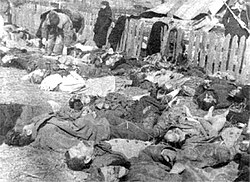
Events
Between 1939 and 1943, Volhynian Poles had been already reduced to some 8% of the region’s population (around 200,000 people). They were dispersed around the countryside, deprived of their elites by Soviet deportations, with neither local partisan army of their own nor state authority (except the Germans) to protect them.[60]
On February 9, 1943, a UPA group commanded by Hryhory Perehyniak, pretending to be Soviet partisans assaulted the Paroślesettlement in Sarny county.[61][62][63] It is considered a prelude[64] to the massacres, and is recognized as the first[64] mass murder committed by the UPA in the area. Estimates of the number of victims range from 149[65] to 173.[66]
In 1943 the massacres were organized westwards, starting in March in Kostopol and Sarny counties. In April they moved to the area of Krzemieniec, Rivne, Dubno and Lutsk.[67] Between late March and early April 1943, killing approximately 7,000 unarmed men, women, and children in its first days.[68]
On the night of April 22–23, Ukrainian groups, commanded by Ivan Lytwynchuk (aka Dubovy), attacked the settlement of Janowa Dolina, killing 600 people and burning down the entire village.[69] Those few who survived were mostly people that found refuge with friendly Ukrainian families.[70][better source needed] In one of the massacres, in the village of Lipniki, almost the entire family of Mirosław Hermaszewski (Poland’s only astronaut) was murdered[71] along with about 180 inhabitants.[72] The attackers murdered the grandparents of composer Krzesimir Dębski, whose parents met each other during the Ukrainian attack on Kisielin.[citation needed] Debski’s parents survived, taking refuge with a friendly Ukrainian family.
In another massacre, according to UPA reports, the Polish colonies of Kuty, in the Szumski region, and Nowa Nowica, in the Webski region, were liquidated for cooperation with the Gestapo and German authorities.”[73] According to Polish sources, the Kuty self-defense unit managed to repel the UPA assault, though at least 53 Poles were murdered. The rest of the inhabitants decided to abandon the village and were escorted by the Germans who arrived at Kuty, alerted by the glow of fire and the sound of gunfire.[74] Maksym Skorupskyi, one of UPA commanders, wrote in his diary: Starting from our action on Kuty, day by day after sunset, the sky was batching in the glow of conflagration. Polish villages were burning.[74]
By June 1943, the attacks had spread to the counties of Kowel, Włodzimierz Wołyński, and Horochów, and in August to Luboml county.[67] The decisive Soviet victory at Kursk acted as a stimulus for escalation of massacres in June and August 1943, when ethnic cleansing reached its peak.[46] In June 1943, Dmytro Klyachkivsky head-commander of the UPA-North made a general decision to exterminate Poles in Volhynia. His secret directive stated: “We should make a large action of the liquidation of the Polish element. As the German armies withdraw, we should take advantage of this convenient moment for liquidating the entire male population in the age from 16 up to 60 years. We cannot lose this fight, and it is necessary at all costs to weaken Polish forces. Villages and settlements lying next to the massive forests, should disappear from the face of the earth”.[75]
In mid-1943, after a wave of killings of Polish civilians, the Poles tried to initiate negotiations with the UPA. Two delegates of the Polish government in Exile and AK,[76] Zygmunt Rumel and Krzysztof Markiewicz attempted to negotiate with UPA leaders, but were captured and murdered on July 10, 1943, in the village of Kustycze.[77] Some sources claim they were tortured before the death.[78]
The following day, July 11, 1943, is regarded as the bloodiest day of the massacres,[by whom?] with many reports of UPA units marching from village to village, killing Polish civilians.[79] On that day, UPA units surrounded and attacked Polish villages and settlements located in three counties – Kowel, Horochow, and Włodzimierz Wołyński. Events began at 3:00 am, leaving the Poles with little chance to escape. After the massacres, the Polish villages were burned to the ground. According to those few who survived, the action had been carefully prepared; a few days before the massacres there had been several meetings in Ukrainian villages, during which UPA members told the villagers that the slaughter of all Poles was necessary.[79] Within a few days an unspecified number of Polish villages were completely destroyed and their populations murdered. In the Polish village of Gurow, out of 480 inhabitants, only 70 survived; in the settlement of Orzeszyn, the UPA killed 306 out of 340 Poles; in the village of Sadowa out of 600 Polish inhabitants only 20 survived; in Zagaje out of 350 Poles only a few survived. In August 1943, the Polish village of Gaj (near Kovel) was burned and some 600 people massacred, in the village of Wola Ostrowiecka 529 people were killed, including 220 children under 14, and 438 people were killed, including 246 children, in Ostrowki. In September 1992 exhumations were carried out in these villages, confirming the number of dead.[79] Altogether, on July 11, 1943, the Ukrainians attacked 167 towns and villages.[80] This wave of massacres lasted 5 days, until July 16. The UPA continued the ethnic cleansing, particularly in rural areas, until most Poles had been deported, killed or expelled. These actions were conducted by many units, and were well-coordinated and thoroughly planned.[46]

In August 1943 the UPA placed notices in every Polish village stating “in 48 hours leave beyond the Bug River or the San river- otherwise Death.”[82] Ukrainian attackers limited their actions to villages and settlements, and did not strike towns or cities.
Polish historian Władysław Filar, who witnessed the massacres, cites numerous statements made by Ukrainian officers when reporting their actions to the leaders of UPA-OUN. For example, in late September 1943, the commandant “Lysyi” wrote to the OUN headquarters: “On September 29, 1943, I carried out the action in the villages of Wola Ostrowiecka (see Massacre of Wola Ostrowiecka), and Ostrivky (see Massacre of Ostrówki). I have liquidated all Poles, starting from the youngest ones. Afterwards, all buildings were burned and all goods were confiscated”.[83] On that day in Wola Ostrowiecka 529 Poles were murdered (including 220 children under 14), and in Ostrówki, the Ukrainians killed 438 persons (including 246 children).[84]
Methods
The atrocities were carried out indiscriminately and without restraint. The victims, regardless of their age or gender, were routinely tortured to death. Norman Davies in No Simple Victory gives a short, but shocking description of the massacres. He writes:
Villages were torched. Roman Catholic priests were axed or crucified. Churches were burned with all their parishioners. Isolated farms were attacked by gangs carrying pitchforks and kitchen knives. Throats were cut. Pregnant women were bayoneted. Children were cut in two. Men were ambushed in the field and led away. The perpetrators could not determine the province’s future. But at least they could determine that it would be a future without Poles.
An OUN order from early 1944 stated:
Liquidate all Polish traces. Destroy all walls in the Catholic Church and other Polish prayer houses. Destroy orchards and trees in the courtyards so that there will be no trace that someone lived there… Pay attention to the fact that when something remains that is Polish, then the Poles will have pretensions to our land”.[11]
Timothy Snyder describes the murders: “Ukrainian partisans burned homes, shot or forced back inside those who tried to flee, and used sickles and pitchforks to kill those they captured outside. In some cases, beheaded, crucified, dismembered, or disembowelled bodies were displayed, in order to encourage remaining Poles to flee”.[86] A similar account has been presented by Niall Ferguson, who wrote: “Whole villages were wiped out, men beaten to death, women raped and mutilated, babies bayoneted.”[87] Ukrainian historian Yuryi Kirichuk described the conflict as similar to medieval rebellions.[88]
According to Polish historian Piotr Łossowski, the method used in most of the attacks was the same. At first, local Poles were assured that nothing would happen to them. Then, at dawn, a village was surrounded by armed members of the UPA, behind whom were peasants with axes, hammers, knives, and saws. All the Poles encountered were murdered; sometimes they were herded into one spot, to make it easier. After a massacre, all goods were looted, including clothes, grain, and furniture. The final part of an attack was setting fire to the village.[89] In many cases, victims were tortured and their bodies mutilated. All vestiges of Polish existence eradicated with even abandoned Polish settlements burned to the ground.[46]
Even though it may be an exaggeration to say that the massacres enjoyed general support of the Ukrainians, it has been suggested that without wide support from local Ukrainians they would have been impossible.[2] Those Ukrainian peasants who took part in the massacres created their own units,[46] called Samoboronni Kushtchovi Viddily (Kushtchov Self-Defence Units). People who did not speak Polish but were considered Poles by the perpetrators were also murdered.[citation needed]
Ukrainians in ethnically mixed settlements were offered material incentives to join in the slaughter of their neighbours, or warned by the UPA’s security service (Sluzhba Bezbeky) to flee by night, while all remaining inhabitants were murdered at dawn. Many Ukrainians risked, and in some cases, lost their lives trying to shelter or warn Poles[86][90] – such activities were treated by the UPA as collaboration with the enemy and severely punished.[91] In 2007, the Polish Institute of National Remembrance (IPN) published a document Kresowa Ksiega Sprawiedliwych 1939 – 1945. O Ukraincach ratujacych Polakow poddanych eksterminacji przez OUN i UPA (“Eastern Borderland’s Book of the Righteous. About Ukrainians saving Poles from extermination of OUN and UIA”). The author of the book, IPN’s historian Romuald Niedzielko, documented 1341 cases in which Ukrainian civilians helped their Polish neighbors. For this, 384 Ukrainians were executed by the UIA.[92] In case of Polish-Ukrainian families, one common UPA instruction was to kill one’s Polish spouse and children born of that marriage. People who refused to carry such order were often murdered together with their entire family.[35][93]
Self-defence organizations
The massacres prompted Poles, starting in April 1943, to organize self-defence organizations, 100 of which were formed in Volhynia in 1943. Sometimes these self-defence organization obtained arms from the Germans; other times the Germans confiscated their weapons and arrested the leaders. Many of these organizations could not withstand the pressure of the UPA and were destroyed. Only the largest self-defence organizations who were able to obtain help from the AK or from Soviet partisans were able to survive.[94]
The AK on 20 July 1943 called upon Polish self-defence units to place themselves under its command. Ten days later, it declared itself in favor of Ukrainian independence on territories without Polish populations, and called for an end to the killings of civilians.[95] Polish self-defence organizations took part in revenge massacres of Ukrainian civilians starting in the summer of 1943, when Ukrainian villagers who had nothing to do with the massacres suffered at the hands of Polish partisan forces. Evidence includes a letter dated August 26, 1943 to local Polish self-defence where AK commander Kazimierz Bąbiński criticized the burning of neighboring Ukrainian villages, killing any Ukrainian that crosses their path, and robbing Ukrainians of their material possessions.[96] The total number of Ukrainian civilians murdered in Volyn in retaliatory acts by Poles is estimated at 2,000-3,000.[97] The 27th Home Army Infantry Division was formed in January 1944, and tasked to fight the UPA and then the Wehrmacht.[95]
Death toll
According to the Volhynian delegation to the Polish government, by October 1943 the number of Polish casualties exceeded 15,000 people.[98] Timothy Snyder estimates that in spring and summer 1943 the UPA actions resulted in deaths of 40,000 Polish civilians.[2]
Eastern Galicia

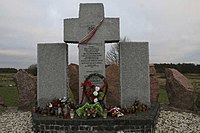

In late 1943 and early 1944, after most Poles in Volhynia had either been murdered or had fled the area, the conflict spread to the neighboring province of Galicia, where the majority of the population was still Ukrainian, but where the Polish presence was strong. Unlike in the case of Volhynia, where Polish villages were usually destroyed and their inhabitants murdered without warning, in east Galicia Poles were sometimes given the choice of fleeing or being killed. An order by an UPA commander in Galicia stated, “Once more I remind you: first call upon Poles to abandon their land and only later liquidate them, not the other way around”). This change in tactics, combined with better Polish self-defense and a demographic balance more favorable to Poles, resulted in a significantly lower death toll among Poles in Galicia than in Volhynia.[99] The methods used by Ukrainian nationalists in this area were the same, and consisted of rounding up and killing all the Polish residents of the villages, then looting the villages and burning them to the ground.[46] On February 28, 1944, in the village of Korosciatyn 135 Poles were murdered;[100] the victims were later counted by a local Roman Catholic priest, Rev. Mieczysław Kamiński.[101] Jan Zaleski (father of Fr. Tadeusz Isakowicz-Zaleski) who witnessed the massacre, wrote in his diary: “The slaughter lasted almost all night. We heard terrible cries, the roar of cattle burning alive, shooting. It seemed that Antichrist himself began his activity!”[102] Father Kamiński claimed that in Koropiec, where no Poles were actually murdered, a local Greek Catholic priest, in reference to mixed Polish-Ukrainian families, proclaimed from the pulpit: “Mother, you’re suckling an enemy – strangle it.” [103] Among the scores of Polish villages whose inhabitants were murdered and all buildings burned, there are such places as Berezowica near Zbaraz, Ihrowica near Ternopil, Plotych near Ternopil, Podkamien near Brody, and Hanachiv and Hanachivka near Przemyślany.[104]
Roman Shukhevych, the UPA commander, stated in his order from 25 February 1944: “In view of the success of the Soviet forces it is necessary to speed up the liquidation of the Poles, they must be totally wiped out, their villages burned … only the Polish population must be destroyed.”[35]
One of the most infamous massacres took place on February 28, 1944, in the Polish village of Huta Pieniacka, with over 1,000 inhabitants. The village served as a shelter for refugees including Polish Jews,[105] as well as a recuperation base for Polish and Communist partisans. One AK unit was active there. In the winter of 1944 a Soviet partisan unit numbering 1,000 was stationed in the village for two weeks.[105][106][106] Huta Pieniacka’s villagers, although poor, organized a well-fortified and armed self-defense unit that fought off a Ukrainian and German reconnaissance attack on February 23, 1944.[107] Two soldiers of the 14th Waffen Grenadier Division of the SS Galicia (1st Ukrainian) Division of the Waffen-SS were killed and one wounded by the villagers. On February 28, elements of the Ukrainian 14th SS Division from Brody returned with 500-600 men, assisted by a group of civilian nationalists. The killing spree lasted all day. Kazimierz Wojciechowski, the commander of the Polish self-defense unit, was drenched with gasoline and burned alive at the main square. The village was utterly destroyed and all of its occupants killed.[106] The civilians, mostly women and children, were rounded up at a church, divided and locked in barns which were set on fire.[108] Estimates of casualties in the Huta Pieniacka massacre vary, and include 500 (Ukrainian archives),[109] over 1,000 (Tadeusz Piotrowski),[110] and 1,200 (Sol Littman).[111] According to IPN investigation, the crime was committed by the 4th battalion of the Ukrainian 14th SS Division[108] supported by UPA units and local Ukrainian civilians.[112]
A military journal of the Ukrainian 14th SS Division condemned the killing of Poles. In a March 2, 1944 article directed to the Ukrainian youth, written by military leaders, Soviet partisans were blamed for the murders of Poles and Ukrainians, and the authors stated that “If God forbid, among those who committed such inhuman acts, a Ukrainian hand was found, it will be forever excluded from the Ukrainian national community.”[105] Some historians deny the role of the Ukrainian 14th SS Division in the killings, and attribute them entirely to German units, while others disagree.[105][verification needed] According to Yale historian Timothy Snyder, the Ukrainian 14th SS Division’s role in the ethnic cleansing of Poles from western Ukraine was marginal.[113]
The village of Pidkamen near Brody was a shelter for Poles, who hid in the monastery of the Dominicans there. Some 2,000 persons, the majority of them women and children, were living there when the monastery was attacked in mid-March 1944 by UPA units, which according to Polish Home Army accounts were cooperating with the Ukrainian SS. Over 250 Poles were killed.[105] In the nearby village of Palikrovy, 300 Poles were killed, 20 in Maliniska and 16 in Chernytsia. Armed Ukrainian groups destroyed the monastery, stealing all valuables. What remained was the painting of Mary of Pidkamen, which now is kept in St. Wojciech Church in Wrocław. According to Kirichuk, the first attacks on the Poles took place there in August 1943 and they were probably the work of UPA units from Volhynia. In retaliation, Poles killed important Ukrainians, including the Ukrainian doctor Lastowiecky from Lviv and a popular football player from Przemyśl, Wowczyszyn.
By the end of the summer, mass acts of terror aimed at Poles were taking place in Eastern Galicia with the purpose of forcing Poles to settle on the western bank of the San River, under the slogan “Poles behind the San”. Snyder estimates that 25,000 Poles were killed in Galicia alone,[114] Motyka estimated the number of victims at 30,000-40,000.[3]
The slaughter did not stop after the Red Army entered the areas, with massacres taking place in 1945 in such places as Czerwonogrod (Ukrainian: Irkiv), where 60 Poles were murdered on February 2, 1945,[115][116] the day before they were scheduled to depart for the Recovered Territories.
By Autumn 1944 anti-Polish actions stopped and terror was used only against those who co-operated with the NKVD, but in late 1944 and in the beginning of 1945 UPA performed a last massive anti-Polish action in Ternopil region.[117] On the night of February 5–6, 1945, Ukrainian groups attacked the Polish village of Barysz, near Buchach: 126 Poles were massacred, including women and children. A few days later on February 12–13, a local group of OUN under Petro Khamchuk attacked the Polish settlement of Puźniki, killing around 100 people and burning houses. Those who survived moved mostly to Prudnik.[118]
Approximately 150[119]-366 Ukrainian and a few Polish inhabitants of Pawłokoma were killed on March 3, 1945 by a former Polish Home Army unit aided by Polish self-defense groups from nearby villages. The massacre is believed to be an act of retaliation for earlier alleged murders by Ukrainian Insurgent Army of nine (or 11) Poles [120] in Pawłokoma and unspecified number of Poles killed by UPA in neighboring villages.
German and Soviet involvement
While Germans actively encouraged the conflict, for most of the time they attempted to not get directly involved. However, there are reports[by whom?] of Germans supplying weapons to both Ukrainians and Poles. Special German units formed from collaborationist Ukrainian, and later Polish auxiliary police were deployed in pacification actions in Volhynia, and some of their crimes were attributed to either the Polish Home Army or the Ukrainian UPA.
According to Yuriy Kirichuk the Germans were actively prodding both sides of the conflict against each other.[121] Erich Koch once said: “We have to do everything possible so that a Pole meeting a Ukrainian, would be willing to kill him and conversely, a Ukrainian would be willing to kill a Pole”. Kirichuk quotes a German commissioner from Sarny whose response to Polish complaints was: “You want Sikorski, the Ukrainians want Bandera. Fight each other”.[121]
The Nazis replaced Ukrainian policemen who deserted from German service with Polish policemen. Polish motives for joining were local and personal: to defend themselves or avenge UPA atrocities.[122] German policy called for the murder of the family of every Ukrainian police officer who deserted and the destruction of the village of any Ukrainian police officer deserting with his weapons. These retaliations were carried out using newly recruited Polish policemen. Though Volhynian Polish participation in the German Police followed UPA attacks on Polish settlements, it provided the Ukrainian Nationalists with useful sources of propaganda and was used as a justification for the cleansing action. OUN-B leader summarized the situation in August 1943 by saying that the German administration “uses Polaks in its destructive actions. In response we destroy them unmercifully.”[123] Despite the desertions in March and April 1943, the auxiliary Police remained heavily Ukrainian, and Ukrainians serving the Nazis continued pacifications of Polish and other villages.[124]
On August 25, 1943, the German authorities ordered all Poles to leave the villages and settlements and move to larger towns.[citation needed]
Soviet partisan units present in the area were aware of the massacres. On May 25, 1943, the commander of the Soviet partisan forces of the Rivne area stressed in his report to the headquarters that Ukrainian nationalists did not shoot the Poles but cut them dead with knives and axes, with no consideration for age or gender.[125]
Number of victims

Polish casualties
The death toll among civilians murdered during the Volhynia Massacre is still being researched. At least 10% of ethnic Poles in Volhynia were killed during this time by the UPA. Accordingly, “Polish casualties comprised about 1% of the prewar population of Poles on territories where the UPA was active and 0.2% of the entire ethnically Polish population in Ukraine and Poland.”[126] Łossowski emphasizes that documentation is far from conclusive, as in numerous cases there were no survivors who would later be able to testify.[citation needed]
The Soviet and Nazi invasions of pre-war eastern Poland, the UPA massacres, and postwar Soviet expulsions of Poles all contributed to the virtual elimination of a Polish presence in the region. Those who remained left Volhynia mostly for the neighbouring province of Lublin. After the war, the survivors moved further west to the territories of Lower Silesia. Polish orphans from Volhynia were kept in several orphanages, with the largest of them around Kraków. Several former Polish villages in Volhynia and Eastern Galicia do not exist any more and those that remain are in ruins.
There is a general consensus among Western and Polish historians that Polish civilian casualties from the UPA in Volhynia range from 35,000 to 60,000.[126] According to Ivan Katchanovski, “the lower bound of these estimates [35,000] is more reliable than higher estimates which are based on an assumption that the Polish population in the region was several times less likely to perish as a result of Nazi genocidal policies compared to other regions of Poland and compared to the Ukrainian population of Volhynia.”[126] Władysław Siemaszko and his daughter Ewa have documented 33,454 Polish victims, 18,208 of which are known by surname.[127] (in July 2010 Ewa Siemaszko increased the accounts to 38,600 documented victims, 22,113 of which are known by surname[128]). At the first ever joint Polish-Ukrainian conference in Podkowa Leśna organized on June 7–9, 1994 by Karta Centre, with almost 50 Polish and Ukrainian participants, an estimate of 50,000 Polish deaths in Volhynia was agreed upon, which they considered to be moderate.[129] According to the sociologist Piotrowski, the UPA actions resulted in an estimated number of 68,700 deaths in Wołyń Voivodeship.[130] Per Anders Rudling states that UPA killed 40,000-70,000 Poles in this area.[35]
The number of Polish civilians killed in Galicia is believed to be between 20,000-25,000,[131] 25,000[16] and 30,000-40,000.[3] Niall Ferguson estimated the total number of Polish victims in Volhynia and Eastern Galicia to be between 60,000 and 80,000,[132] G. Rossolinski-Liebe: 70,000-100,000,[133] John P. Himka: 100,000.[6] According to Grzegorz Motyka, from 1943 to 1947 in all territories that were covered by the conflict, approximately 80,000-100,000 Poles were killed.[97]
Some extreme estimates place the number of Polish victims as high as 300,000.[134][verification needed]
Ukrainian casualties
Ukrainian casualties at the hands of Poles are estimated at 2,000-20,000 in Volhynia [35][135] and 1,000-20,000 for Eastern Galicia.[135][136] For all areas affected by conflict, the Ukrainian casualties are estimated as from 10,000 to 30,000 between 1943 and 1947.[135][137] However, according to G.Motyka, the estimation of 30,000 Ukrainian casualties is baseless.[135] Ukrainian deaths also include those which occurred during Operation Vistula.[135] Timothy Snyder states that it is likely the UPA killed as many Ukrainians as it did Poles, as local Ukrainians who did not adhere to the OUN’s form of nationalism were regarded as traitors.[4] Within a month of the beginning of the massacres, Polish self-defense units responded in kind; all conflicts resulted in Poles taking revenge on Ukrainian civilians.[4] According to Grzegorz Motyka, the number of Ukrainian victims is between 2,000-3,000 in Volhynia and between 10,000-15,000 in all territories covered by the conflict.[135] There were also atrocities committed by Soviet Partisans and German policemen as part of the conflict of World War II, compounding casualties. G. Rossolinski-Liebe puts the number of Ukrainians (both OUN-UPA members and civilians) killed by Poles during and after the World War at 10,000-20,000.[133]
Disputes
According to Gregorz Motyka, author of a fundamental monograph about the UPA,[138] estimations of 30,000 Ukrainian casualties are unsupported.[135]
Table
| = Historian | = Poli Sci | = Research |



